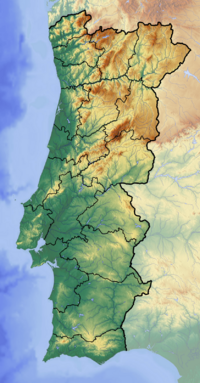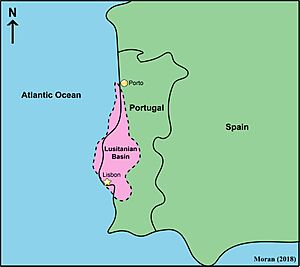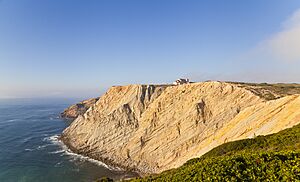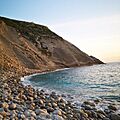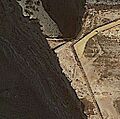Cape Espichel facts for kids
Quick facts for kids Cape Espichel |
|
|---|---|
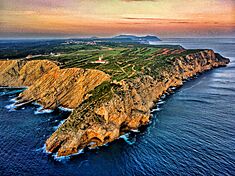
Cape Espichel as seen from the air, looking eastwards.
|
|
| Highest point | |
| Peak | Cape Espichel |
| Elevation | 134 m (440 ft) |
| Naming | |
| Native name | Error {{native name}}: an IETF language tag as parameter {{{1}}} is required (help) |
| Geography | |
| Location | Castelo, Sesimbra, Portugal |
Cape Espichel is an amazing place on the western coast of Portugal. It's a pointy piece of land that sticks out into the Atlantic Ocean. Imagine a high plateau, over 130 meters (about 426 feet) above the sea. This plateau is surrounded by dramatic, steep cliffs.
From Cape Espichel, you can see incredible views. Look north to Cascais and the Sintra Mountains. To the southeast, you can see beaches south of Tróia and even further to Sines. Cape Espichel is also part of important protected areas. These include the Espichel Special Protection Zone and the Arrábida / Espichel Special Conservation Zone. It is also part of the beautiful Arrábida Natural Park.
Nature's Story at Cape Espichel
How the Land Was Formed
The Big Picture
Cape Espichel is located in something called the Lusitanian Basin. Think of a basin as a large bowl-shaped dip in the Earth's surface. This basin formed when the North Atlantic Ocean started to open up. This process began a very long time ago, in the Triassic period, and it's still happening today!
Cliffs and Earthquakes
When the Atlantic Ocean began to spread, Portugal was on the eastern edge of this new ocean. The land was stretching apart. This stretching created big cracks in the Earth called normal faults. One of these was the Arrábida Fault. Its path is now mostly underwater, just south of the cape.
Later, the way the Earth's plates moved changed. The land started to push together instead of pulling apart. This caused the Arrábida Fault to move in the opposite direction. This pushing and squeezing of the land created the amazing, steep cliffs you see at Cape Espichel today. The rocks were folded upwards, and over time, the top parts wore away, leaving these dramatic sea cliffs.
Layers of Rock
The cliffs at Cape Espichel are like a giant book of Earth's history. They show layers of rock from the Late Jurassic and Early Cretaceous periods. These layers are made of different materials like limestone, clay, and sandstone. They were laid down in various coastal environments long ago.
You can see these layers clearly along the western cliffs. They tilt upwards as you go north from the cape. It's like a natural cross-section of the Earth, especially when viewed from the sea!
Ancient Life: Dinosaurs!
The area around Cape Espichel is famous for its fossils. You can find marine coral and mollusk fossils here. But the most exciting finds are the dinosaur footprints! These are found about one kilometer (about half a mile) northeast of the cape, on the cliff walls of Lagosteiros Bay.
- Pedra da Mua Natural Monument is on the south side of the bay. Here, you can see footprints from the Late Jurassic period. Scientists found tracks left by a herd of seven small sauropod dinosaurs. This was the first time such group behavior was found for these dinosaurs in Europe!
- Lagosteiros Natural Monument is on top of the north side cliffs. These footprints are from the Early Cretaceous period. They are the first known Early Cretaceous dinosaur tracks found in Portugal.
Plants and Animals
The landscape at Cape Espichel is typical of the Mediterranean region. You'll find many shrubs and small trees here.
Some plants, like Juniperus turbinata and kermes oak, grow best in sheltered areas. These are often at the bottom of small valleys where the soil is thicker and holds more water.
In open, windy areas with thin soil, you'll see a low bush forest. It's mainly made up of Thymus zygis and a special plant called Ulex densus.
On the coastal cliffs, where the wind and saltwater spray are strong, plants are tougher. Here, you'll find plants like Limonium species and rock samphire. They grow in small cracks and dips in the limestone rocks.
People's Story at Cape Espichel
Ancient Times
Stone Age Life
People have lived in the Cape Espichel area for a very long time. Archaeological finds show that hunter-gatherer groups were here during the Paleolithic period. This means people lived here over ten thousand years ago! They left behind stone tools and other items.
Burial Sites
During the Neolithic period (around 6,000 to 5,000 years ago), Cape Espichel might have been seen as a special place. It may have been a boundary between the living and the dead. Traces of ancient burial practices have been found. In caves facing the sea, archaeologists discovered pottery and human bone remains. These finds tell us about the spiritual beliefs of people from this time.
Later History
Roman Times
When the Romans were in the Iberian peninsula, their presence at the cape was small. Romans often thought of capes as sacred places where gods met. An ancient writer named Avienius called Cape Espichel Cabo Cêmpsico. Later, the geographer Strabo called it Promontorium Barbaricum.
Arabic Influence
The Umayyad Caliphate once ruled the area of Espichel. However, no archaeological evidence of Muslim settlements has been found. Still, some local place names have Arabic roots. For example, Azóia, the village closest to the cape, comes from Al Zawiya, meaning hermitage.
The Middle Ages
During the Middle Ages, many legends drew people to Cape Espichel. It also became a symbol of Portuguese pride. On July 29, 1180, a brave knight named Sir Fuas Roupinho won Portugal's first naval victory here. He fought against the caliphate's forces in the waters off Cape Espichel.
The Lady of the Cape Legend
Near the Pedra da Mua Natural Monument, there's a small building called the Shrine of Memory. It sits alone on the cliff edge. This spot is linked to a famous legend. People believed that the dinosaur footprints below were made by the Holy Virgin. The story says she came up from the sea on a mule, leaving tracks in the solid rock. She appeared to two pilgrims who had traveled far after dreaming of her.
This legend led to an annual pilgrimage to the remote site. Because so many people visited, the Sanctuary of Our Lady of Cape Espichel was built. This complex includes the Church of Our Lady of the Cape and places for pilgrims to stay.
Other Important Buildings
Fort of Our Lady of the Cape
In 1672, a small fort was started west of the religious shrine. It was called the Fort of Our Lady of the Cape. Sadly, in 1796, half of the fort fell into the sea because the cliff edge collapsed. By 1802, the rest of the fort was likely taken down.
Today, you can still see faint outlines of the fort's foundations. If you look closely on the ground or in aerial photos, you can spot where the old defensive wall used to be near the cliff edge.
Cape Espichel Lighthouse
The Cape Espichel Lighthouse was built in 1790. It stands about six hundred meters (about 1,968 feet) south of the sanctuary. It's a strong, hexagonal tower with thick stone walls. It has helped guide ships for centuries.


